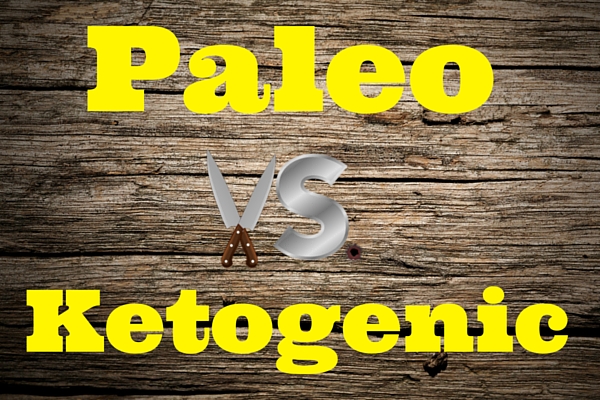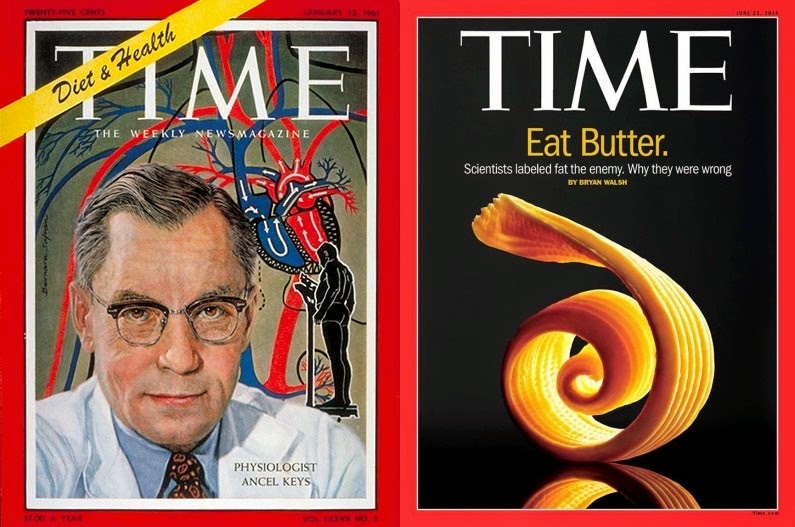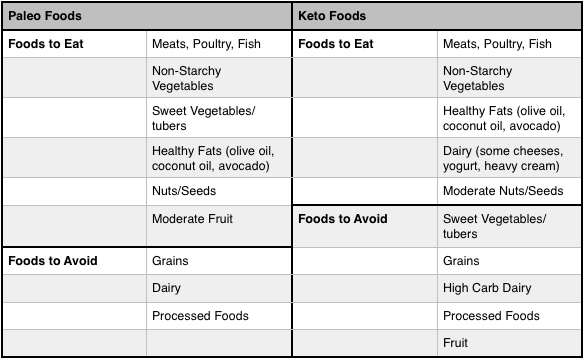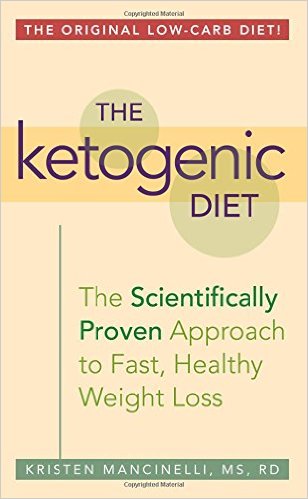
Paleo vs Keto Diet: What’s the difference?
Paleo vs Keto: What’s the difference between the diets?
Everyone is always looking for the quickest way to lose weight. Whether it be low-fat, low-carb, high-fat or high protein, there can be something valuable in whichever diet you choose.
I’d just like to quickly say, I don’t believe that there is one diet that’s right for everyone. Those who are trying to sell you one diet as the be-all-end-all are a little too one sided in my opinion. That said, there are some very effective ways to drop weight fast using the Paleo Diet or the Ketogenic Diet.
“Paleo vs Keto” …often, these diets get lumped together in the same category. While they have a lot of similarities, they also have a lot of differences.
If you’re stumbling upon this blog via a google search marathon on how to lose weight fast, I completely understand why you might be confused right now. Let me help you understand the difference between the Paleo Diet and the Ketogenic Diet.
The Paleo Diet (Quick Background)
When thinking whether to go Paleo vs Keto, you’ll need to know a little history of both. The Paleo Diet was originally introduced into mainstream culture back in 2002 by Dr. Loren Cordain.
Dr. Cordain did decades of extensive research around the diets of our Paleolithic Ancestors after reading an article in the New England Journal of Medicine, back in1987. This article struck a nerve with Dr. Cordain. This triggered an obsession around knowing more about the Paleolithic people and how they ate.
His book, The Paleo Diet was the first of it’s kind, failing miserably for the first seven years in book stores. However, in 2009, the book started to take on a cult like following. This caused the book to skyrocket in sales and quickly become a trending diet in mainstream media.
You might have also heard the term Primal Diet, Ancestral Diet, Caveman Diet or Hunter Gatherer Diet. They are all versions of the original Paleo Diet, but just stamped with someone else’s spin in order to make money. It’s all basically the same. Remember that when you feel completely overwhelmed with information.
Okay, enough about the history.
What is the Paleo Diet?
Imagine a time when humans had to forage for their food. Hunting and gathering whatever we could find was a major part of survival.
What would our ancestors eat? Well, depending on their geographical location, they’d probably eat vegetables and meat for most of the year. Maybe fruits and berries in the hotter months and picking nuts and seeds as often as we could. That would be the extent of it.
The argument for this particular diet is that we, as a human race, developed more in this time than any other time in history. Physically and mentally. But, since the Paleolithic Era, we haven’t really developed much at all.
That’s right, our brains and bodies haven’t changed since. Well, we might have slightly better grooming. 🙂 It stands to reason that our food was the biggest catalyst of this evolutionary leap forward.
So, why stop eating that way? If we not only survived, but thrived on this diet, why did we change it? The answer is, we got smarter and therefore lazier.
We started growing grains and domesticating animals. This made it easier to stay in one area without having to roam around looking for food. It was great for a while until we started eating more processed food created in factories rather than the simple foods that our ancestors ate. So what foods are Paleo?
Paleo Foods
Following the Paleo Diet is actually much more simple than you think.
It might be a shock to your normal way of eating, but once you get used to it, you might wondering why you never thought to eat like this before. You can eat all meats, vegetables, nuts, seeds, fruits and berries.
Yes, there are some recommendations as to how much you should eat of each food. For example fruits and berries were much harder to come by in the paleolithic era. Depending on your geographical location, you might only have access to those foods a few months out of the year. So, the general recommendation would be to eat them in moderation.
No grains or dairy are recommended on the Paleo Diet. Why no grains? The theory is, if we didn’t have pots or ovens to cook the food, then how would we consume them? Ever try eating a raw piece of corn or a bag of uncooked rice? Not gonna happen. On the dairy side, our ancestors hunted cattle and didn’t raise them for milk.
Paleo Macronutrient Profile
According to Dr. Loren Cordain, the Paleo diet is a high-protein diet. However I’ve interviewed many Paleo experts in the past and they don’t hold such a dogmatic opinion. The general consensus is that you should fill most of your plate with leafy green vegetable, such as kale, spinach or broccoli. If you’d like to eat starchy vegetables such as squash or pumpkin, you can have a small portion of that too.
The rest of your plate will be taken over by well-sourced meats. The fat content in the meat doesn’t matter as long it’s well sourced. This means that the animals should be grass-fed, free range or pasture raised. If you’re not sure about food labels and how to chose the best meats, check out this podcast with Andy Bellati.
If you’re interested in learning more about the Paleo Diet, check out this podcast interview with the “father” of Paleo, Dr. Loren Cordain or pick up his book, The Paleo Diet on Amazon.
The Ketogenic Diet (Quick History)
Now you have some knowledge of the Paleo part of the Paleo vs Keto discussion. Now, lets help you to understand the Keto part.
The Ketogenic diet became popular in the medical community back in the 1920’s and 30’s as a treatment for patients with epilepsy. Without going into the depths of the medical history, it fell by the wayside after a drug took the place of the diet.
For years, only a few doctors still prescribed the Ketogenic diet as a treatment for epilepsy. It wasn’t until decades later that we started using the Ketogenic diet to lose weight. Not only does it help reduce body fat by a process called Ketosis, it also helps lower blood sugar, decreases appetite and increase good cholesterol.
So why isn’t everyone doing the Ketogenic Diet?
What is the Ketogenic Diet?
The main reason this diet is controversial is that it’s a high-fat diet. I know what you’re thinking, fat is bad for you because it makes you fat, so why would I want to eat a high fat diet. The answer is…you’ve been fed the wrong information for so long, you just believe fat is bad without questioning it’s validity.
Back in the 1960’s there was a lot of political pressure to solve the growing heart disease epidemic sweeping the nation. Someone had to come to the rescue and save the American people from themselves. This person was Ancel Keys, a doctor who convinced the nation that “fat” is the root cause of heard disease and that we should steer clear of it at all costs.
Once he convinced the American Heart Association, that was the end of eating saturated fat and the beginning of a low-fat diet crazy that has lasted until today. Check out this interview with Nina Teicholz, author of the Big Fat Surprise: Why Butter, Meat and Cheese Belong in a Healthy Diet. It will blow your mind to find out that we’ve been lied to since the 1960’s because one man wanted to save the day and further his career.
Ancel Keys on the cover of the times in 1961.

The Ketogenic Breakdown
Let me step off my soap box and tell you what the diet entails. When looking at a Paleo vs Keto macronutrient ratio, we explained that paleo doesn’t really have a magic number ratio. The ketogenic diet however is very specific. It’s a high-fat, moderate protein and low-carb diet. The breakdown is as follows
70% fat
25% protein
5% carbohydrates
This might seem like a lot of fun when you first consider starting a Ketogenic diet, but assure you, it takes planning. It’s harder than you think to keep your net carbohydrate intake at or between 20-50 grams per day(the recommended amount). The “net carbohydrate” count is the total carbohydrate minus the fiber.
Thus, kale has a net carbohydrate count of 6 (7 g of total carbs – 1 g fiber = 6 g net carbs). The goal is to reach a state of ketosis, where your body burns ketones as a source of energy, rather than glucose. A ketone is the energy source derived from fat. This triggers a fat burning chain reaction in the body, allowing you to burn fat very fast and efficiently. Only problem is, it takes about 8 days to reach ketosis and if you slip up by eating too many carbs, you’ll be kicked out of ketosis, slowing your weight loss down dramatically.
Keto Transition
You will also experience something called “keto flu.” It’s a transition period the body goes through when switching over from glucose burning to ketone burning. During that time you’ll feel exhausted and have mental cloudiness. This phase is normal, but no fun at all.
Once you’ve reached the other side and are officially in ketosis, your body will burn fat as a source of fuel and you’ll feel significantly more energized. This is good news for those who want to lose body fat fast.
In the beginning, as you transition, you might experience extreme weight loss. Anywhere from 5 to 15 pounds in the first week or two. This is normal. Because glucose naturally holds 4 grams of water per 1 gram of glucose stored in the body, your water weight will drop very quickly.
Keep this in mind if you transition out of ketosis by eating carbohydrates again. You will immediately put on X amount of water weight. Don’t worry, it’s not fat.
How Long Should you Stay in Ketosis?
Some people choose to live a Ketogenic Lifestyle, cycling in and out of ketosis. Others choose to stay in ketosis indefinitely. That is a personal choice that you’ll have to make for yourself.
If you’re body fat has dropped, you’re maintaining a good lean body mass, your energy levels are through the roof and you’re feeling fantastic, stick with it! As they say, if it ain’t broke, don’t fix it.
If you’re interested in hearing more, check out my interview with Kristen Mancinelli, author of The Ketogenic Diet.
Paleo vs Keto Foods
The foods on the Ketogenic diet are similar to the Paleo diet, but again with much more specific ratios. Like the Paleo diet, the Keto diet consists mostly of meat, vegetables, and healthy fats.
Grains are also not recommended because of the carbohydrate count (ie. 1/2 cup brown rice=20 grams carbs). However sweet vegetables like sweet potatoes and tubers are also not consumed on the Ketogenic diet because of the high carb count.
In contrast to Paleo, high fat dairy is allowed on the ketogenic diet like cheeses and heavy cream while fruit (with the exception of berries) is generally too high in carbs to be consumed.
Nuts and seeds can be eaten in moderation, but again contain some carbs so have to be counted. Thus, Keto is really about keeping the ratio of 5% carbs, 20% protein, and 75% healthy fats where Paleo is more specific about what types of foods to eat.

Paleo vs Keto Summary
Both the Paleo and Ketogenic Diet can be fantastic ways to lose weight.
When it comes to Paleo vs Keto, in my opinion the Ketogenic diet is the quickest route to achieving extreme weight lose, however it’s much more difficult to maintain. The Paleo diet is a much easier style of eating that can be easily adapted when going out to restaurants or having dinner parties.
Rob’s Recommendation
If you need to drop 10 to 20 pounds, I’d recommend just trying a Paleo diet. You should start to lose one to two pounds per week. That’s pretty standard and a safe marker for success. I
f you need to drop more than that, say 30 or 100 pounds, I’d highly recommend trying the ketogenic diet. Then, after you’ve dropped the necessary weight, transition into the Paleo diet as a way to maintain.
Thus, you don’t have to think Paleo vs Keto as they are both great diets and can be used in combination together as a plan for healthy and successful weight loss.
I hope you have enjoyed reading Paleo vs Keto. Please feel free to comment. I’m happy to hear your feedback.
And remember, always consult a physician before trying any new diet, especially if you have any medical conditions.

